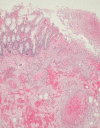Phlegmonous colitis: another source of sepsis in cirrhotic patients?
- PMID: 20003486
- PMCID: PMC2800109
- DOI: 10.1186/1471-230X-9-94
Phlegmonous colitis: another source of sepsis in cirrhotic patients?
Abstract
Background: The clinical relevance of phlegmonous colitis (PC), a rare autopsy finding in cirrhotic patients, is poorly documented. We postulated that PC might be a source of sepsis in patients with portal hypertensive colopathy (PHC).
Case presentation: We report three cirrhotic patients who were admitted with abdominal sepsis and who illustrate, to various degrees, the clinico-pathological sequence of colonic alterations associated with portal hypertension. Two cirrhotic patients with PHC developed gram-negative bacteraemia and quickly responded to intravenous antibiotics. Another cirrhotic patient underwent emergency colectomy for PC, and subsequently died from multiple organ failure. Histological alterations in the operative specimen included: a) mucosal ulcerations; b) disseminated micro-abscesses in the submucosa; and c) a severe vasculopathy leading to complete obliteration of submucosal blood vessels.
Conclusions: These data suggest that cirrhotic patients with PHC may progress towards PC, which, in turn, may be the cause for life-threatening sepsis.
Figures





Similar articles
-
Liver disease, phlegmonous colitis, and gram-negative sepsis.South Med J. 1975 Apr;68(4):507-10. doi: 10.1097/00007611-197504000-00027. South Med J. 1975. PMID: 1091983
-
Phlegmonous colitis. Report of a case.Am J Clin Pathol. 1969 Mar;51(3):338-43. doi: 10.1093/ajcp/51.3.338. Am J Clin Pathol. 1969. PMID: 4885297 No abstract available.
-
Colonic mucosal changes in patients with liver cirrhosis.Gastrointest Endosc. 1995 Nov;42(5):408-12. doi: 10.1016/s0016-5107(95)70040-4. Gastrointest Endosc. 1995. PMID: 8566628
-
A case of fulminant portal pyemia complicating hemicolectomy for polyps: literature review and case report.J Gastrointest Surg. 2010 May;14(5):926-8. doi: 10.1007/s11605-009-0959-7. Epub 2009 Jul 7. J Gastrointest Surg. 2010. PMID: 19582518 Review.
-
Mesenteric phlebosclerosis: a new disease entity causing ischemic colitis.Dis Colon Rectum. 2003 Feb;46(2):209-20. doi: 10.1097/01.DCR.0000044720.43258.6E. Dis Colon Rectum. 2003. PMID: 12576895 Review.
Cited by
-
Post-endoscopic submucosal dissection phlegmonous enteritis: A case report and literature review.Heliyon. 2023 Dec 9;10(1):e23467. doi: 10.1016/j.heliyon.2023.e23467. eCollection 2024 Jan 15. Heliyon. 2023. PMID: 38173497 Free PMC article.
-
[Bacterial colitis].Pathologe. 2011 Sep;32(5):371-8. doi: 10.1007/s00292-011-1492-5. Pathologe. 2011. PMID: 21935759 Review. German.
-
Multifocal Colonic Wall Abscesses during Anti-Tumor Necrosis Factor (TNF)-α Therapy for a Patient with Ulcerative Colitis: A Very Rare Manifestation of Infectious Complications.Intern Med. 2017;56(10):1157-1161. doi: 10.2169/internalmedicine.56.8041. Epub 2017 May 15. Intern Med. 2017. PMID: 28502929 Free PMC article.
References
-
- Viggiano TR, Gostout CJ. Portal hypertensive intestinal vasculopathy: a review of the clinical, endoscopic and histopathological features. Am J Gastroenterol. 1992;87:944–54. - PubMed
-
- Mendeloff J, Wenger J. Liver disease, phlegmonous colitis, and gram-negative sepsis. South Med J. 1975;68:507–10. - PubMed
Publication types
MeSH terms
Substances
LinkOut - more resources
Full Text Sources
Medical

